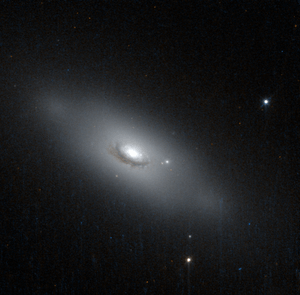NGC 1260
| NGC 1260 | |
|---|---|
 NGC 1260 imaged by the Hubble Space Telescope | |
| Observation data (J2000 epoch) | |
| Constellation | Perseus |
| Right ascension | 03h 17m 27.2s[1] |
| Declination | +41° 24′ 19″[1] |
| Redshift | 0.01919[1] |
| Helio radial velocity | 5753 ± 14 km/s[1] |
| Distance |
250 ± 1.6 Mly (76.7 ± 0.5 Mpc)[2] |
| Apparent magnitude (V) | 14.3[1] |
| Characteristics | |
| Type | S0/a[1] |
| Apparent size (V) | 1′.1 × 0′.5[1] |
| Other designations | |
| UGC 02634, PGC 012219, MCG +07-07-047[1] | |
NGC 1260 is a spiral or lenticular galaxy[3] in the constellation Perseus.[4] It was discovered by astronomer Guillaume Bigourdan on October 19, 1884.[5] NGC 1260 is a member of the Perseus Cluster[6][7] and forms a tight pair with the galaxy PGC 12230.[7] In 2006, it was home to the second brightest supernova in the observable universe, supernova SN 2006gy.

Supernova 2006gy imaged by the Swift spacecraft
References
- 1 2 3 4 5 6 7 8 "NASA/IPAC Extragalactic Database". Results for NGC 1260. Retrieved 2007-05-07.
- ↑ "Distance Results for NGC 1260". NASA/IPAC Extragalactic Database. Retrieved 2010-05-04.
- ↑ Hakobyan, A. A.; Petrosian, A. R.; McLean, B.; Kunth, D.; Allen, R. J.; Turatto, M.; Barbon, R. (2008-06-24). "Early-type galaxies with core collapse supernovae". Astronomy & Astrophysics. 488 (2): 523–531. arXiv:0806.4269. doi:10.1051/0004-6361:200809817. ISSN 0004-6361.
- ↑ "Revised NGC Data for NGC 1260". spider.seds.org. Retrieved 2018-06-17.
- ↑ "New General Catalog Objects: NGC 1250 - 1299". cseligman.com. Retrieved 2018-06-17.
- ↑ Brunzendorf, J.; Meusinger, H. (October 1, 1999). "The galaxy cluster Abell 426 (Perseus). A catalogue of 660 galaxy positions, isophotal magnitudes and morphological types". Astronomy and Astrophysics Supplement Series. 139 (1): 141–161. doi:10.1051/aas:1999111. ISSN 0365-0138.
- 1 2 Hakobyan, A. A.; Petrosian, A. R.; McLean, B.; Kunth, D.; Allen, R. J.; Turatto, M.; Barbon, R. (2008-06-24). "Early-type galaxies with core collapse supernovae". Astronomy & Astrophysics. 488 (2): 523–531. arXiv:0806.4269. doi:10.1051/0004-6361:200809817. ISSN 0004-6361.
External links
- Brightest object found in NGC 1260 (Space.com : 7 May 2007)
- http://www.solstation.com/x-objects/sn2006gy.htm
- NGC 1260 on WikiSky: DSS2, SDSS, GALEX, IRAS, Hydrogen α, X-Ray, Astrophoto, Sky Map, Articles and images
This article is issued from
Wikipedia.
The text is licensed under Creative Commons - Attribution - Sharealike.
Additional terms may apply for the media files.